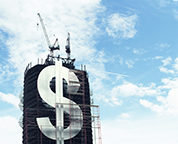If the manufacturing plant category is excluded, nonresidential building in 2014 would be up 11%, after an 8% increase in 2013 on a similar basis.
The commercial building group in 2014 advanced 15%, led by a 28% increase for the office category that featured the start of such projects as the $2.3-billion office portion of the $2.5-billion Apple corporate headquarters in Cupertino, Calif., and the $806-million office portion of the $933-million Comcast Innovation and Technology Center in Philadelphia.
The top five metropolitan areas ranked by the dollar volume of new office starts in 2014 were: New York City, San Jose, Houston, Philadelphia and Chicago. The other commercial categories showed this performance in 2014—hotels, up 23%; warehouses, up 18%; and stores and shopping centers, unchanged from the previous year.
The institutional building group for all of 2014 increased 8%, marking the first gain since 2008. The educational facilities category rose 12% and featured greater activity for these major segments—K-12 school construction, up 18%; and college and university construction, up 19%. Increases were also reported for public buildings, up 13%; amusement-related work, up 12%; and transportation terminals, up 10%. The health care facilities category in 2014 did not participate in the broad upward trend, as it slipped 1%. Church construction in 2014 continued to be depressed, falling an additional 10%.
Residential Building
Residential building in December improved 3% to $247.3 billion (annual rate). Multifamily housing climbed 14%, lifted by groundbreaking for two residential towers in New York City, valued at $384 million and $275 million, respectively.
Additional multifamily projects in December included $208 million for the multifamily portion of a $675-million, mixed-use tower in Miami and $171 million for the multifamily portion of a $200-million, mixed-use tower in Boston. Single-family housing in December settled back 1%, as it maintained the essentially flat pattern that was present throughout 2014.
The 2014 amount for residential building was $227.8 billion, up 8%, and a much smaller increase than what was reported in 2012, up 31%; and 2013, up 26%.
Single-family housing grew just 2% in dollar terms, considerably less than its 27% jump in the previous year. The regional pattern for single-family housing in 2014 was mixed. Gains were reported in the South Central, up 7%; the South Atlantic, up 3%; and the Northeast, up 2%; while declines were reported in the West, down 1%; and the Midwest, down 2%.
Multifamily housing in 2014 climbed 28% and has now shown annual dollar gains in excess of 20% for five straight years. By major region, multifamily housing revealed this performance in 2014—the Northeast, up 41%; the South Atlantic, up 30%; the South Central, up 23%; the Midwest, up 20%; and the West, up 17%.
The top five metropolitan areas in terms of the 2014 dollar amount of multifamily starts were: New York City, Miami, Washington, D.C., Los Angeles and Boston. Metropolitan areas ranked six through 10 were: Chicago, Seattle, San Francisco, Philadelphia and Dallas-Ft. Worth.
Nonbuilding Construction
Nonbuilding construction in December plummeted 32% to $124.3 billion (annual rate), following its 21% hike in November. A large share of December’s decline was due to a 79% plunge for the electric power and gas plant category, which had been boosted in November by the start of the $3.6-billion Dominion Cove Point LNG Liquefaction project in Maryland and a $571-million natural gas-fired power plant in Virginia.
Although December did include a $500-million retrofit of four coal-fired power plants in Alabama, this was not enough to cushion the category’s steep December drop.
New public works projects in December fell a more moderate 10% and reflected decreased activity for water supply systems, down 25%; and miscellaneous public works (sitework, mass transit, pipelines), down 43%. On the plus side, highway and bridge construction in December increased 2% and included the start of the $555-million Kosciuszko/Newtown Creek bridge rehabilitation project in Brooklyn and Queens, N.Y. Growth in December was also reported for river/harbor development, up 3%; and sewer construction, up 6%.
For the full year 2014, nonbuilding construction dropped 6% to $139.2 billion, which followed the 9% decline reported for 2013. Public works construction overall in 2014 was down 7%, sliding back after its 12% gain in the previous year. Highway and bridge construction retreated 15% from a very strong amount in 2013 that included several substantial bridge projects, such as the $3.1-billion Tappan Zee Bridge replacement in New York. Declines were also reported for river/harbor development, down 6%; and water supply systems, down 7%. Annual gains were reported for miscellaneous public works, up 4% (with much of the support coming from increased mass transit work), and sewer construction, up 8%.
The electric utility and gas plant category in 2014 retreated 2%, a much smaller drop than the 55% plunge in 2013. While alternative power generation projects (primarily solar and wind) were down sharply, more traditional power generation plants held steady, and natural gas plants increased with the start of the Dominion Cove Point LNG Liquefaction project.
The 7% gain for total construction starts at the national level in 2014 was the result of greater activity in all five major regions. Leading the way was the South Central, up 14%; followed by the South Atlantic, up 11%; the West, up 7%; the Northeast, up 2%; and the Midwest, up 1%.

